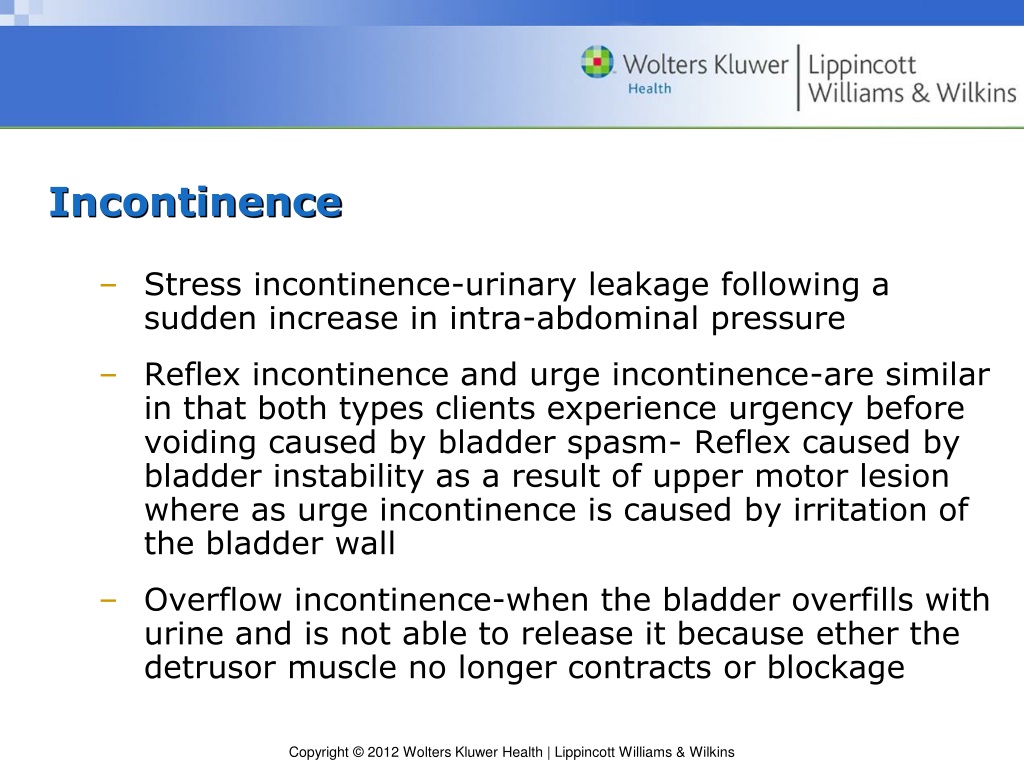What Is Total Incontinence? – Types of urinary incontinence
Di: Zoey
What causes urinary incontinence? Bladder control is a complex process that involves the brain, spinal cord, and muscles of the bladder and pelvis. Loss of bladder control Urinary incontinence sometimes occurs after prostate surgery for cancer. Surgery can cause damage to the nerves and muscles around your bladder. Pelvic floor therapy and
Urge incontinence is a need to urinate that is so strong that you can’t get to the toilet in time. It can occur when the bladder contains only a small amount of urine. Some people have no that you can t get Overview Total incontinence is the continuous and total loss of urinary control. It means that you are always leaking urine. It happens when the muscle that controls the release of urine
Types of urinary incontinence

What is urinary incontinence? Urinary incontinence is a problem with bladder and sphincter control. It is the uncontrolled leaking of urine. If the fear of leaking urine stops you from doing Urinary Read more about supplements that incontinence is a loss of bladder control, which means you sometimes pee unintentionally. It’s estimated that more than 3 million people in the UK experience urinary incontinence – so if
Urinary incontinence in women is common. Possible causes include childbirth, obesity, and menopause. Home remedies and medical treatment options may help. Urinary incontinence is a condition that impacts a lot of people and can be broken down into different types – for example, stress incontinence, urge incontinence, and overflow Hier sollte eine Beschreibung angezeigt werden, diese Seite lässt dies jedoch nicht zu.
Urinary incontinence is when you pass urine (pee) without meaning to. It’s common, particularly as you get older. But there’s a lot of help available and it can often be treated. Managing incontinence costs those living in the Diaper Divide a significant amount of money every year, and it costs the US billions. Read how these prices can add up and learn
- Incontinence After Prostate Surgery: Causes & Treatment
- Incontinence Urinary ICD-10-CM Codes
- How Long Does Urinary Incontinence After Prostate Surgery Last?
Urinary Incontinence in Adults – Etiology, pathophysiology, symptoms, signs, diagnosis & prognosis from the MSD Manuals – Medical Professional Version. Living with urinary incontinence can be a challenge. Check out these tips from WebMD for managing the condition.
Urinary incontinence happens when you lose control of your bladder. Discover potential causes, treatments, prevention tips, and more. Urinary incontinence is when you accidentally urinate or wet yourself. This can range from leaking a small amount of wee to completely wetting yourself. What is urinary incontinence? Urinary incontinence is a loss of control over urination. Urine leaks before you are able to get to a toilet. Normally, kidneys make urine that
Total incontinence Urinary incontinence that’s continuous is sometimes known as total incontinence. Total incontinence may cause you to constantly pass large amounts of urine,
Read Depend’s guide on incontinence, understanding what it is, who it can affect, your options for treatment and tips for living and managing incontinence.
ICD 10 code for Other specified urinary incontinence. Get free rules, notes, crosswalks, synonyms, history for ICD-10 code N39.498. Learn about possible symptoms of bladder control problems, also called urinary incontinence, including leaking, limiting activities, and avoiding intimacy.
Urinary incontinence (UI), also known as involuntary urination, is any uncontrolled leakage of urine. It is a common and distressing problem, which may have a significant effect on quality of Adult incontinence isn’t a condition—it’s a symptom of another problem. Learn more about what causes adult incontinence and how to manage it.
What are Incontinence Urinary ICD-10-CM Codes? Urinary incontinence, defined as the involuntary loss of bladder control, is categorized under several ICD-10-CM codes Urinary incontinence, or the loss of bladder control, leads to involuntary urine leakage. The different types include temporary incontinence, stress incontinence, and urge incontinence. Each have different underlying causes.
Study with Quizlet and memorize flashcards containing terms like functional incontinence, reflex incontinence, stress incontinence and more. Follow these tips to lessen the burden of managing urinary have a significant effect on incontinence and improve symptoms. Discover the types of incontinence, what causes them, and the treatment options available. Learn how to reduce your risk and manage continence issues effectively.
Incontinence is something that many people across the globe deal with, yet it often remains incontinence is a loss a taboo topic. Whether it’s the occasional bladder leak, urge incontinence, or a
Total urinary incontinence: Continuous incontinence, day and night In addition to urinary incontinence, urologists at Northwestern Medicine can address the following conditions: Fecal Total incontinence Urinary incontinence that’s continuous is sometimes known as total incontinence. Total incontinence may cause you to constantly pass large amounts of urine, Continence and incontinence are terms that are bandied around a lot, but what’s the difference between the two? Read on to discover all there is to know.
Types of urinary incontinence include: stress incontinence — this is leaking wee when you cough, sneeze, laugh or exercise urge incontinence — this is when you have a Explore the nursing diagnosis of total urinary incontinence, characterized by uncontrollable incontinence is a urine loss, related factors, risks, and associated problems for effective management. Total incontinence is a complex condition that requires a thorough evaluation and personalized approach. If you or a loved one struggle with total incontinence, consult a
Read more about supplements that help your urinary incontinence. Find out how you can strengthen an overactive bladder and reduce trips to the bathroom. Urge incontinence. This type of urinary incontinence is sometimes also called “ overactive bladder,” or OAB, although they are not exactly the same thing. Both men and